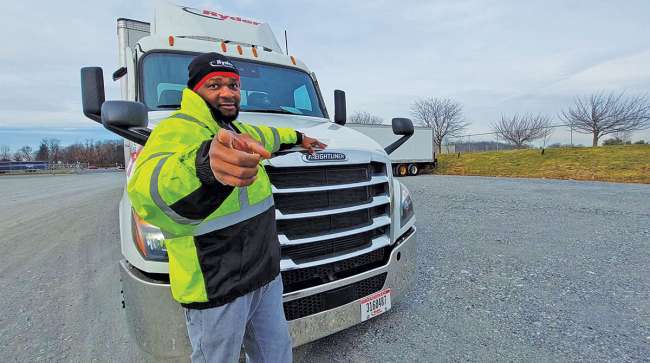Special to Transport Topics
Social Media Platforms Open Fleets to Newer Recruiting Pool

[Stay on top of transportation news: Get TTNews in your inbox.]
When he started driving for Ryder two years ago, Maurice Walker never thought he’d be a social media personality. Then, Walker agreed to be featured in a driver testimonial on Ryder’s YouTube channel.
“I was shocked. It was my first day with my trainer,” he said of the experience. “But I said, ‘I’ll see where it takes me.’ I was a little nervous, getting put on the spot, but other than that, it was fine.” Since then, the video has been seen more than 1,200 times.
Fleets like Ryder are looking more to social media platforms to increase brand awareness, reach new customers and, increasingly, find new employees. It’s a trend that has its roots decades ago in the digital revolution, but it’s one that has accelerated quickly and forced companies to evolve rapidly to capitalize on new media opportunities.
Abigail Lawson, senior director of recruitment with Ryder, said the social media push began when traditional methods of connecting with potential employees began to shut down.
“Basically, we were all forced to go outside of traditional job boards and try to find where candidates were — and social media is where a lot of people are,” Lawson explained.
Ryder Supply Chain Solutions, which ranks No. 9 on the Transport Topics Top 100 list of the largest for-hire carriers in North America and No. 10 on the TT 100 logistics list, uses the channel to promote career opportunities to potential recruits. Other companies have used other social media outlets like Facebook, Instagram and TikTok to target specific audiences or grow brand awareness.

Peters
“We knew we were going through this digital revolution. What we didn’t realize is how fast it would happen, and how the technology would really come into play for recruiters,” said Priscilla Peters, chief marketing officer with Conversion Interactive Agency, a recruitment advertising firm. She also contended that along with the changes to how a company’s message is being delivered, the messaging itself is changing.
“If you told me 10 years ago that we would have drivers on TikTok doing little dances and telling people about why you should drive for the carrier they drive for, I would’ve said, ‘Oh, well, that’s a little far-fetched’ — but here we are,” she continued.
Successful social media campaigns tend to be attention-getting, entertaining, humorous and produced to connect with a broad audience. Popular accounts feature interesting characters discovered in the mechanic shop or follow drivers as they showcase life on the road; others interview long-term drivers about their careers and love for the lifestyle. Showing videos provides the highest impact and emotional connection, Peters said, and using humor and wit to appeal to the widest audience delivers the best performance for posts.

Jazrawy
“If you are just using it as a big advertisement, it doesn’t work,” added Jane Jazrawy, CEO of CarriersEdge. “When you want to attract people, you can’t just say, ‘Hey, it’s great here, and we have these rates, and come work for us.’ ”
She said a better strategy is to engage and involve the company’s existing employees in creating videos and acting as brand ambassadors online, similar to how Ryder approached Walker with his first-day-on-the-job shoot.
“If you involve your current drivers and create a community, it’s much more powerful,” Jazrawy said.
Getting started with a social media recruitment campaign doesn’t have to be a money- or tech-intensive project. Recruiters across the industry agree that launching a successful campaign starts with existing employees.
“If you have men and women who are drivers for you, they’re already ‘influencers,’ ” said Peters. People who like their jobs and feel empowered by them tend to share those details online, she pointed out. “You probably have a gold mine of influencers, whether you realize it or not.”
It’s important to make sure that the content being shared is relevant, timely and even a little goofy, she added. It’s also important to remember that social media casts a much wider net to potential applicants than a traditional targeted job fair or recruiting event would.
“When it’s more engaging, fun, memes or funny videos and things like that — those get a lot of comments, a lot of interaction, a lot of engagement from drivers, but they don’t necessarily bring in leads. But that’s still great because you’re starting conversations, you’re working that top of the lead funnel,” Peters said.
COMTO's April Rai offers tips to increase workforce diversity and grow profits.. Tune in above or by going to RoadSigns.ttnews.com.
She said her “lead funnel” starts even before drivers start looking for their next job. Engaging videos help build brand preference and bring the company to top of mind when the driver is ready to start seeking their next position.
Ashley St. John, director of talent recruiting with Ryder, added that social media can introduce truck driving careers to people who never considered it as an employment path.
“You’re giving (potential applicants) the opportunity to not only read about the position, but to see and hear it from a similar person really helps engage their interests, makes them more comfortable, and gets them over that hump of, ‘Would I be qualified’ to ‘Hey, I could do that job. I saw it, I feel it. I can do it,’ ” she said.
Jazrawy said it’s important to decide on post timing, platform and frequency, as well as staying consistent and making sure there’s a commitment and buy-in from the team to launch and maintain the accounts, and then stay engaged with current and potential employees as the campaign matures.
St. John said tracking the success of social media campaigns is different from traditional recruitment metrics.
Want more news? Listen to today's daily briefing above or go here for more info
“Not everybody will like a post, but if you have a ton of views and the time that they’re watching, the video tells you that they’re engaged,” she said, “and then track likes, shares, tags.” All of that, she said, hopefully adds up to increased employment candidate leads.
For Ryder, the video shoot with Walker on his first day on the job had an impact. He immediately shared the video with his family and friends and got permission to use images from the video on his LinkedIn accounts. He also got a decal for his truck. When he’s on the road, people recognize him from his online presence and strike up conversations about his life and career.
Over the past two years, he said, four people have gone on to accept positions with Ryder after speaking with him.
“I’ve had people come up to me to try to get their son a job and ask how they go about getting their Class A license,” he said.





